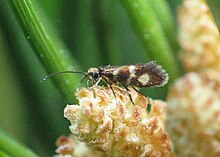| Micropterigidae Temporal range:
| |
|---|---|

| |
| Micropterix aureoviridella (Höfner, 1898) | |
| Scientific classification | |
| Domain: | Eukaryota |
| Kingdom: | Animalia |
| Phylum: | Arthropoda |
| Class: | Insecta |
| Order: | Lepidoptera |
| Suborder: | Zeugloptera Chapman, 1917[1] |
| Superfamily: | Micropterigoidea Herrich-Schäffer, 1855 |
| Family: | Micropterigidae Herrich-Schäffer, 1855 |
| Genera | |
|
See text | |
| Diversity | |
| About 180 species | |
Micropterigoidea is the superfamily of "mandibulate archaic moths", all placed in the single family Micropterigidae, containing currently about twenty living genera. They are considered the most primitive extant lineage of lepidoptera (Kristensen, 1999), and the sole superfamily in the suborder Zeugloptera. The name comes from the Greek for mikros, little and pterux, a wing.[2] Unique among the Lepidoptera, these moths have chewing mouthparts rather than a proboscis, and are seen feeding, often in large aggregations, on the pollen of the flowers of many herbaceous plants, shrubs and trees.[3][4] The fossil record of the group goes back to the middle-late Jurassic with the earliest known species being Auliepterix from the Karabastau Formation in Kazakhstan.

- ^ van Nieukerken et al (2011) Order Lepidoptera Linnaeus, 1758. In: Zhang, Z.-Q. (Ed.) Animal biodiversity: An outline of higher-level classification and survey of taxonomic richness, Zootaxa 3148, 212-221
- ^ Smith, Frank. "Microlepidoptera (Micro-Moths)". Cornwall and Isles of Scilly Federation for Biological Recorders. Retrieved 30 August 2019.
- ^ Sterling, Phil; Parsons, Mark; Lewington, Richard (2012). Field Guide to the Micromoths of Great Britain and Ireland. Milton-on-Stour: British Wildlife Publishing. p. 46. ISBN 978-0-9564902-1-6.
- ^ Heath, John (1983). Micropterigidae. In The Moths and Butterflies of Great Britain and Ireland. Volume 1. Colchester: Harley Books. p. 151. ISBN 0-946589-15-1.